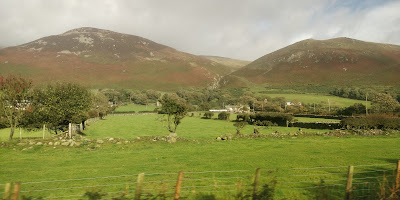 |
| Kent's Bank |
The weather looked like misbehaving so I postponed the adventure I've been postponing all week. I decided instead to get an old man's explorer ticket and go up to Cumbria, which I haven't visited this past couple of months. The plan was that if it was only mizzly I'd see what was on offer from a walk round Cavendish Dock in Barrow, if it was raining properly I'd go up as far as Ulverston to check out the Kent and Leven estuaries on the train then come back for a wander round Leighton Moss. Looking at the absolutely filthy weather when we reached Lancaster I decided to stay on the train and go up the Cumbrian coast. It worked out that if I got to Whitehaven I'd only have a short wait for the train back to Lancaster.
The lousy weather meant the birdwatching through the window was a bit sparse: even most of the woodpigeons were staying undercover. The tide was incoming but low as we left Lancaster and there wasn't a lot on the coastal pools, though a great white egret showed well. A paperchase of little egrets littered the salt marshes of Morecambe Bay. There was a lot of monochrome birdwatching: carrion crows, jackdaws, rooks or black-headed gulls herring gulls and little egrets. It came as a relief when the train spooked some curlews just outside Grange over Sands. Every so often there'd be a field full of white patches as flocks of gulls gritted their beaks and sat out the weather, every one of them facing into the wind, and herds of sheep hunched miserably with their faces away from the wind.
The Leven was still low when we passed over it. There were a lot of black-headed gulls and eiders loafing on the mud banks and cormorants drying their wings by the track.
The weather was filthy at Barrow, confirming my intention to keep nice and dry on the train. We started passing fields of Herdwick sheep that didn't seem to notice the weather was a tad inclement. The wind and tide pushed the water high up the streams past Kirkby-in-Furness and flocks of black-headed gulls hunkered down on the marsh with the crows and jackdaws. Oddly, as we crossed the Duddon proper it was still quite low.
 |
| Braystones |
High tide on the Irish Sea coast was wild and woolly and not for the first time I wondered how — or if! — those waterside houses at Braystones and Nethertown get home insurance. At Ravenglass even the eiders took shelter behind the spit on the river by the station.
We arrived at Whitehaven and I got out and stretched my legs. The weather was exactly how I remember Whitehaven but there was more colour, it was mostly grey and brown last time I visited. About five minutes before the train to Lancaster arrived the wind blew out the rain. It was like some transformation scene: literally one minute it was sheeting down and cold, the next it was a warm sunny day.
 |
| Whitehaven |
The transformation worked its magic on the bird life. All of a sudden there were robins and blackbirds in the bushes and goldfinches and greenfinches flying overhead. The trip back down couldn't have been much more different to the trip up to Whitehaven. The sunshine brought out the birds and they seemed keen to make up for lost time, here and there (particularly on the River Esk just before Ravenglass) I had trouble picking out the runners and riders in the crowd scenes. There were large flocks of rooks, jackdaws and black-headed gulls most of the way to Carnforth.
There were hunting buzzards and kestrels along the line between Whitehaven and St Bees. There's a bit of a wait at St Bees while the drivers exchange tokens for the single track North, I spent the time watching red admirals feeding on the potted plants. There were more later on when we called at Silecroft.
The river Esk was heaving with birds. There were hundreds of black-headed gulls and many dozens of greylag geese. I was so bewildered by both that I can't tell you how many cormorants, mallards or herring gulls there were. I nearly missed pairs of teal and lesser black-backs and definitely missed who knows how many others.
 |
| Whitebeck |
I was astonished to see three swallows chasing each other round a telegraph pole at Bootle Station.
The osprey nest at Green Road looks bigger than last year but showed no signs of recent occupation.
 |
| Green Road |
The ducks on the Leven as we passed over it included mallards, eiders, wigeon and a lone redhead goosander and there was a hundred or more pink-footed geese on the marsh.
Morecambe Bay's salt marshes still had their little egrets and curlews and now the visibility was better I could see the lapwings in the fields. The Kent was still high and fifty-odd redshanks huddled on the rocks by the rail viaduct. Fifty or more black-tailed godwits graced the reedbed pools the other side of the line to Leighton Moss' coastal hides.
The weather had turned so nicely I contemplated having a late walk round Cavendish Dock or Leighton Moss but decided against as the train connections are a lot iffy that time of day. No rail journey through Lancaster would be complete without a complete meltdown on the West Coast Mainline. So we had one.

No comments:
Post a Comment